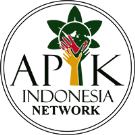KONTRIBUSI HASIL HUTAN BUKAN KAYU KEMIRI (Aleurites moluccana) TERHADAP PENDAPATAN PETANI HUTAN KEMASYARAKATAN (HKm) TANGGA DESA SELENGEN KECAMATAN KAYANGAN KABUPATEN LOMBOK UTARA
DOI:
10.29303/jbl.v1i2.64Published:
2018-08-01Issue:
Vol. 1 No. 2 (2018)Keywords:
Community Forest, Contribution of Candlenut, Farmer’s IncomeArticles
Downloads
How to Cite
Downloads
Metrics
Abstract
This research was intended to find Contribution of Non-Timber Forest Products Candlenut (Aleurites Moluccana) to Farmer’s Income of Tangga, supporting and inhibiting factors, and income improvement strategy of business non-timber forest products candlenut. The research location in Tangga hamlet, Selengen Village, Kayangan District, North Lombok Regency, West Nusa Tenggara Province. This research used interview method with questionnaire tool to 36 respondents was carried on February 2018. The results showed Contribution of Non-Timber Forest Products Candlenut from region farmer community to farmer’s income was 63.2% /area of arable land or 63% /hectares, which support farmers to cultivate candlenut because it is very easy to develop, does not require intensive maintenance, harvest activities were very easy to do, technology tools used were traditional, and marketing process was easy to do. As well as barriers in the miscellaneous management of the lack of capital and the availability of limited tools in the processing of candlenut so that farmers can only sell candlenut in the form of logs that will reduce the income it receives, as well as the lack of knowledge and skills possessed by farmers. Income-generating strategy of the candlenut can be done with SO strategy (Strenght-Opportunity) that is developing the potency of candlenut with skill owned by farmer by utilizing simple tool technology. As well as increased cultivation and intensive candlenut intensive maintenance by utilizing the existing land area.References
Anantanyu, S. (2011). Kelembagaan petani: Peran dan strategi pengembangan kapasitasnya. Jurnal Sosial Ekonomi Pertanian dan Agribisnis, 7(2), 102-109.
Husinsyah. 2006. “Kontribusi Pendapatan Petani Karet Terhadap Pendapatan Petani Di Kampung Mencimai.†Epp 3 (1): 9–20.
Ichsan, A. C. (2018). Kinerja Pembangunan Kesatuan Pengelolaan Hutan Lindung Sungai Wain dan DAS Manggar di Provinsi Kalimantan Timur. Jurnal Belantara, 1(1).
Indrasari, Desi, Christine Wulandari, and Afif Bintoro. 2017. “Pengembangan Potensi Hasil Hutan Bukan Kayu Oleh Kelompok Sadar Hutan Lestari Wana Agung Di Register 22 Way Waya Kabupaten Lampung Tengahâ€. 5 (1): 81–91.
Markum, Setiawan B, dan Sabani R. 2014. Hutan Kemasyarakatan Sebuah Ikhtiar Mewujudkan Hutan Lestari Masyarakat Sejahtera. Balai Pengelolaan Daerah Aliran Sungai Dodokan Moyosari Nusa Tenggara Barat: RA Visindo. ISBN 978-062-74279-0-7.
Menteri Lingkungan Hidup dan Kehutanan Republik Indonesia. 2016. “Peraturan Menteri Lingkungan Hidup Dan Kehutanan Republik Indonesia Nomor 83/MENLHK/SETJEN/KUM.1/2016 Tentang Perhutanan Sosial.†Kementerian Lingkungan Hidup Dan Kehutanan, 1–45.
Menteri Kehutanan Republik Indonesia. 2007. “Peraturan Menteri Kehutanan Republik Indonesia Nomor P.21/Menhut-II/2009 Tentang Kriteria dan Indikator Penetapan Jenis Hasil Hutan Bukan Kayu Unggulan.†Kementerian Kehutanan, 1–28.
Menteri Kehutanan Republik Indonesia. 2007. “Peraturan Menteri Kehutanan Republik Indonesia Nomor P.37/Menhut-II/2007 Tentang Hutan Kemasyarakatan.†Kementerian Kehutanan, 1–22.
Menteri Kehutanan Republik Indonesia. 2006. “Peraturan Menteri Kehutanan Republik Indonesia Nomor P.55/Menhut-II/2006 Tentang Penataan Hasil Hutan Yang Berasal Dari Hutan Negara.†Kementerian Kehutanan No. 1: 1–52.
Nasrul, W. (2012). Pengembangan Kelembagaan Pertanian Untuk Peningkatan Kapasitas Petani Terhadap Pembangunan Pertanian. Menara Ilmu, III(29), 166–174.
Raja, Eduardus, Antara made, dan Anam Haerul. 2016. “Strategi Pengembangan Usaha Pengelolaan Hutan Tanaman Rakyat Di Desa Bumi Beringin Kecamatan Luwuk Kabupaten Banggai†Jurnal e-katalogis 4 (1) : 215-228.
Sanudin. 2009. “Strategi Pengembangan Hutan Rakyat Pinus Di Kabupaten Humbang Hasundutan Sumatera Utara†Jurnal Analisis Kebijakan Kehutanan 6 (2) :131 - 149
Silamon, Rato Firdaus. 2014. Rencana Strategis Pengelolaan HHBK Kabupaten Lombok Utara Sebuah Produk Aksi Partisipatif. Program Studi Kehutanan. Universitas Mataram. Prosiding ISBN 978-602-71618-1-8.
Soekartawi. 2002. Analisis Usahatani. Universitas Indonesia Press, Jakarta.
Sugiyono. 2014. Metode Penelitian Kuantitatif Kualitatif dan R&D. Alfabeta. Bandung.
Syahrizal. 2015. “Strategi Pengembangan Hutan Kemasyarakatan Dengan Pola Agroforestry Di Desa Amal Kecamatan Sindue Kabupaten Donggalaâ€. Jurnal Sains dan Teknologi Tadulako 4 (1) : 39-48
Waluyo dan A. I. Sari. 2014. Penguatan ekonomi kreatif masyarakat lereng Merapi melalui peningkatan keterampilan dan produktivitas usaha. Jurnal Pertanian. 2(11):307-317
WWF Indonesia Program Nusa Tenggara. 2012. Rencana Pengelolaan Hasil Hutan Bukan Kayu Di Kawasan HKm Kabupaten Lombok Utara. WWF Indonesia Program Nusa Tenggara.
WWF Indonesia Program Nusa Tenggara. 2016. Analisis Rantai Nilai dan Insentif Ekonomi Komoditas HHBK Unggulan Pulau Lombok. Yayasan WWF Indonesia.
License
The Authors submitting a manuscript has understood that if accepted for publication on Jurnal Belantara, the copyright of the article shall be assigned to Jurnal Belantara of the Forest Study Program University of Mataram as the publisher of the journal. Copyright encompasses rights to reproduce and deliver the article in all forms and media, including reprints, photographs, microfilms, and any other similar reproductions, as well as translations.
Jurnal Belantara of the Forest Study Program University of Mataram and the Editors make every effort to ensure that no wrong or misleading data, opinions, or statements be published in the journal. In any way, the contents of the articles and advertisements published in Jurnal Belantara are the sole responsibility of their respective authors and advertisers.
We strongly encourage that manuscripts be submitted to the online journal system in http://belantara.unram.ac.id/index.php/JBL/index. Authors are required to create an account and submit the manuscripts online. For submission inquiries, please follow the submission instructions on the website. If the author has any problems with the online submission, please contact Editorial Office at the following email: [email protected]
Contributors are responsible for obtaining permission to reproduce any materials, including photographs and illustrations, for which they do not hold the copyright and for ensuring that the appropriate acknowledgments are included in the manuscript.
Users of this website will be licensed to use materials from this website following the Creative Commons Attribution 4.0 International License. No fees charged. Please use the materials accordingly.











